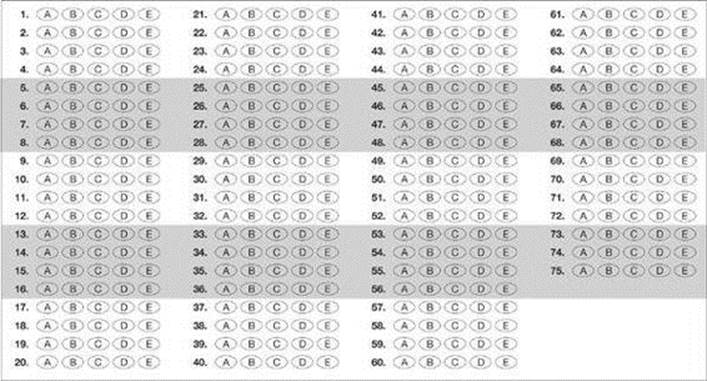SAT Subject Test Physics (2012)
PART IV. TWO FULL-LENGTH PRACTICE TESTS
PRACTICE TEST 1
Treat this practice test as the actual test, and complete it in one 60-minute sitting. Use the following answer sheet to fill in your multiple-choice answers. Once you have completed the practice test:
1. Check your answers using the Answer Key.
2. Review the Answers and Explanations.
3. Complete the Score Sheet to see how well you did.
ANSWER SHEET
Tear out this answer sheet and use it to complete the practice test. Determine the BEST answer for each question. Then fill in the appropriate oval.
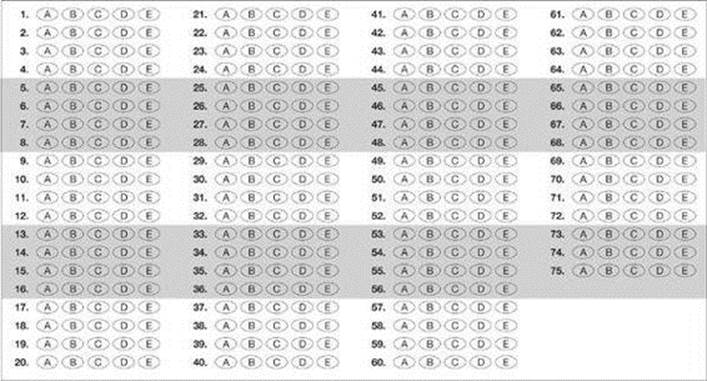
PRACTICE TEST 1
Part A
Directions: Each set of lettered choices refers to the numbered questions of statements immediately following it. Select the one lettered choice that best answers each question or best fits each statement, and then fill in the corresponding oval on the answer sheet. A choice may be used once, more than once, or not at all in each set.
Questions 1–4 refer to the following nuclear equations.
![]()
![]()
![]()
![]()
![]()
1. Which of the equations is an example of alpha decay?
2. Which of the equations is an example of beta decay?
3. Which of the equations is an example of nuclear fusion?
4. Which of the equations is an example of nuclear fission?
Questions 5–8 refer to the following physical principles. Identify the principle that best explains each observation.
(A) Newton’s first law of motion
(B) Newton’s second law of motion
(C) Newton’s third law of motion
(D) Law of universal gravitation
(E) Kepler’s Laws of Motion
5. An acorn speeds up as it falls from a tree.
6. An astronaut moves backward upon throwing a pack of tools in space.
7. In a tug-of-war, the rope does not move when the two teams are pulling equally hard in opposite directions.
8. Jupiter holds many moons in orbit around it.
Questions 9–12 refer to the images described below. F represents focal distance.
(A) real, upright image
(B) real, inverted image
(C) virtual, upright image
(D) virtual, inverted image
(E) no image
9. Which can result from an object placed between the center of curvature and the focal point of a converging mirror?
10. Which can result from an object placed inside the focal length of a diverging lens?
11. Which can result from an object placed a distance of 2F in front of a converging lens?
12. Which can result from an object placed between the focal point and the surface of a converging mirror?
Part B
Directions: Each of the questions or incomplete statements below is followed by five suggested answers or completions. Select the one that is best in each case, and then fill in the corresponding oval on the answer sheet. Do not use a calculator.
13. What is the magnitude of 2A – B in the figure below?
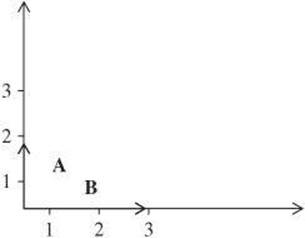
(A) 2
(B) 5
(C) 6
(D) 7
(E) 9
14. The three lowest energy levels of an atom are shown. In a single transition, an atom in the n = 3 state can spontaneously emit a photon having an energy of
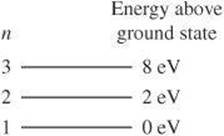
(A) 8 eV only
(B) 2 eV only
(C) 6 eV only
(D) 2 eV and 6 eV only
(E) 6 eV and 8 eV only
15. The angle of incidence in the diagram below is θ. Which number represents the angle of reflection?
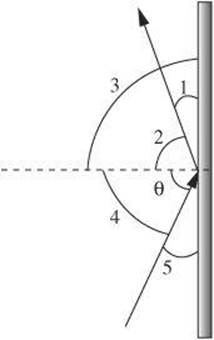
(A) 1
(B) 2
(C) 3
(D) 4
(E) 5
Questions 16 and 17 refer to the diagram of a wave shown below.
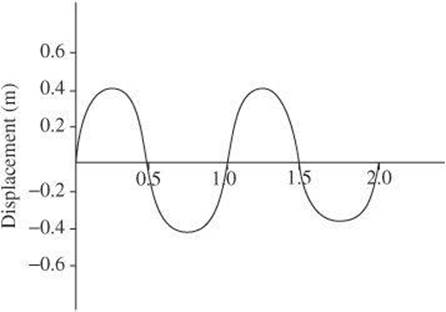
16. What is the wavelength of the wave?
(A) 0.4 m
(B) 0.5 m
(C) 0.8 m
(D) 1.0 m
(E) 2.0 m
17. What is the period of the wave?
(A) 0.071 s
(B) 0.142 s
(C) 0.153 s
(D) 0.180 s
(E) 0.200 s
18. A sound wave from a guitar string travels at a speed of 200 m/s. If the frequency of the wave is 440 Hz, what is its wavelength?
(A) 0.20 m
(B) 0.45 m
(C) 2.2 m
(D) 4.0 m
(E) 8.8 m
19. An astronomer discovers a planet with two moons. One moon is 2 times as far from the center of the planet as the other and 3 times the mass of the other moon. What is the ratio of the gravitational force on the first moon to the gravitational force on the second moon?
(A) 0.33
(B) 0.40
(C) 0.66
(D) 0.75
(E) 0.90
Questions 20 and 21 refer to a 2.0-kg block of ice to which heat is added. The specific heat of water is 4.2 × 103 J/kg°C and the heat of fusion of ice is 3.3 × 105 kJ/kg.
20. How much heat is required to melt the block of ice?
(A) 1.2 × 104 J
(B) 6.5 × 104 J
(C) 1.7 × 105 J
(D) 6.6 × 105 J
(E) 8.4 × 105 J
21. Once the ice melts, heat is added until the temperature of the water reaches 30°C. How much heat is required to raise the temperature from 0°C to 30°C?
(A) 8.4 × 104 J
(B) 2.5 × 105 J
(C) 3.0 × 105 J
(D) 6.0 × 105 J
(E) 1.9 × 106 J
22. Which of the graphs below can be used to represent the magnetic field established at the center of a coil by a steady current in the coil?
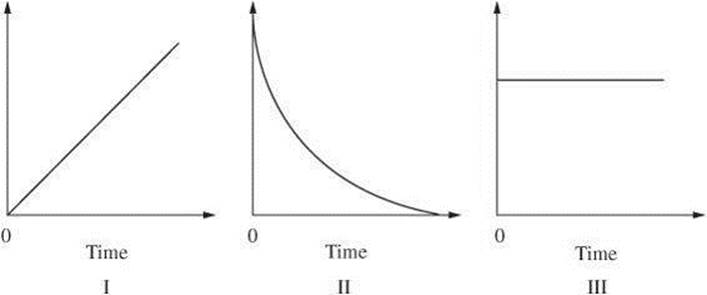
(A) I only
(B) II only
(C) III only
(D) I and III only
(E) none of these
23. A 1-newton force and a 4-newton force act in opposite directions. What is the magnitude of the resultant force, in newtons?
(A) 0
(B) 1
(C) 3
(D) 4
(E) 5
24. All of the following are kinds of electromagnetic waves EXCEPT
(A) blue light
(B) gamma rays
(C) ultraviolet radiation
(D) alpha rays
(E) X-rays
Questions 25 and 26 refer to the diagram below of an airplane traveling at 400 kph at an angle of 25° from north.
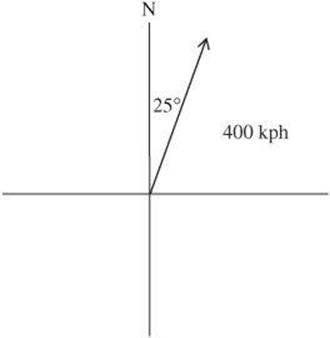
25. What is the plane’s northward speed?
(A) 160.0 kph
(B) 169.0 kph
(C) 186.5 kph
(D) 362.5 kph
(E) 400 kph
26. What is the plane’s eastward speed?
(A) 169.0 kph
(B) 265 kph
(C) 335 kph
(D) 362.5 kph
(E) 400 kph
27. The cross-sectional area of an engine cylinder is 0.020 m2. If a gas in the cylinder exerts a constant pressure of 6.5 × 105 Pa on the piston to move it a distance of 0.050 m, the amount of work done by the gas is
(A) 43 J
(B) 52 J
(C) 5.5 × 102 J
(D) 6.5 × 102 J
(E) 7.5 × 102 J
28. Which statements(s) about the circuit shown is true?
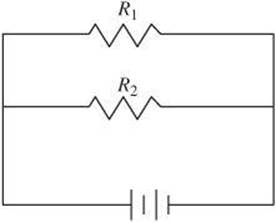
I. The sum of the currents in R1 and R2 equals the total current.
II. R 1 and R2 have the same potential different across them.
III. The sum of R1 and R2 gives the equivalent resistance of the circuit.
(A) I only
(B) II only
(C) III only
(D) I and II only
(E) II and III only
29. Which particle is formed when radium–226 undergoes alpha decay according to the equation below?
![]()
![]()
![]()
![]()
![]()
![]()
30. The mass of an object is doubled. How must the magnitude of the force change if the magnitude of the acceleration is also doubled?
(A) It is quartered.
(B) It is halved.
(C) It is unchanged.
(D) It is doubled.
(E) It is quadrupled.
31. What is the missing particle in the nuclear equation below?
![]()
![]()
![]()
![]()
![]()
![]()
32. A hiker walks 46.2 degrees north of east for 1.5 km and then due east for 2.5 km. What is the hiker’s total displacement from the starting point if you measure the distance along a straight line?
(A) 1.0 km
(B) 1.7 km
(C) 3.7 km
(D) 3.8 km
(E) 4.0 km
33. Two small conducting spheres are identical except that sphere X has a charge of –6 microcoulombs and sphere Y has a charge of +8 microcoulombs. After the spheres are brought in contact and then separated, what is the charge on each sphere, in microcoulombs?
(A) sphere X (+1), sphere Y (+1)
(B) sphere X (0), sphere Y (+2)
(C) sphere X (–1), sphere Y (+1)
(D) sphere X (–2), sphere Y (–1)
(E) sphere X (+2), sphere Y (0)
34. Which of the following will increase the strength of an electromagnet?
I. Increase the density of coils of wire.
II. Remove the iron core from the solenoid.
III. Change the direction of the current through the wire.
(A) I only
(B) II only
(C) III only
(D) I and II only
(E) I and III only
35. Which of the following is the largest quantity?
(A) 0.35 m
(B) 35 × 10–3 m
(C) 3.5 × 10–6 m
(D) 0.000035 × 102 m
(E) 0.0000035 × 103 m
36. A process adds 10 joules of heat to an ideal gas, which causes the gas to do 6 joules of work. Which of the following is true about the internal energy of the gas during this process?
(A) It decreases by 16 joules.
(B) It decreases by 4 joules.
(C) It remains the same.
(D) It increases by 4 joules.
(E) It increases by 16 joules.
Questions 37 and 38 refer to the circuit diagram below, which includes a 12-V battery, three resistors, and a current of 1.5 A.
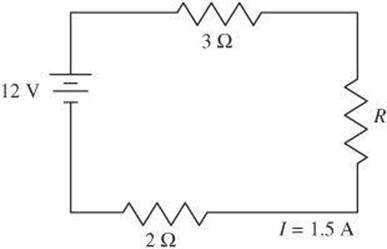
37. What is the value of the unknown resistor?
(A) 3.0 Ω
(B) 4.0 Ω
(C) 5.0 Ω
(D) 6.0 Ω
(E) 8.0 Ω
38. What amount of power is dissipated through the 2-Ω resistor?
(A) 1.3 W
(B) 3.0 W
(C) 4.5 W
(D) 6.5 W
(E) 9.0 W
39. The kinetic energy of an object increases by a factor of 16. What happens to its speed?
(A) decreases by 4 times
(B) decreases by 2 times
(C) remains the same
(D) increases by 4 times
(E) increases by 16 times
40. In a system, Q represents the energy transferred to or from a system by heat and W represents the energy transferred to or from a system by work.
![]() and
and ![]()
![]() and
and ![]()
![]() and Q = 0
and Q = 0
![]() and Q = 0
and Q = 0
Which condition(s) will lead to an increase in the internal energy of the system?
(A) I only
(B) I and IV only
(C) II only
(D) II and III only
(E) II and IV only
41. Which best describes the shape of the magnetic field lines established by a straight wire carrying a strong current?
(A) straight lines parallel to the wire pointing in the same direction as the current
(B) straight lines parallel to the wire pointing opposite to the current
(C) straight lines perpendicular to the wire
(D) concentric circles surrounding the wire
(E) circles on either side of the wire
Questions 42 and 43 relate to the diagram below, which shows a point charge + Q is fixed in the position shown. Each letter represents a charge in the plane of the page.
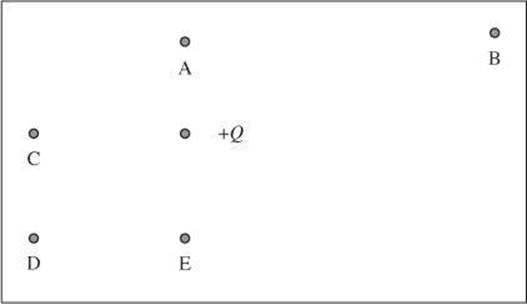
42. Which point will experience a electric field with the least magnitude?
(A) A
(B) B
(C) C
(D) D
(E) E
43. At which point would an electron experience a force directed toward the bottom of the page?
(A) A
(B) B
(C) C
(D) D
(E) E
44. The statements below relate to nuclear reactions.
I. Increases atomic number.
II. Decreases atomic number.
III. Increases mass number.
IV. Decreases mass number.
Which of the above statements are true of alpha decay?
(A) I only
(B) II only
(C) I and III only
(D) II and III only
(E) II and IV only
45. Force A and Force B act on an object. Let theta equal the angle between the directions of the two forces. At what value of theta is the resultant force the greatest?
(A) 0°
(B) 45°
(C) 60°
(D) 90°
(E) 180°
46. The diagram shows an electric circuit with a resistor R connected to a battery.
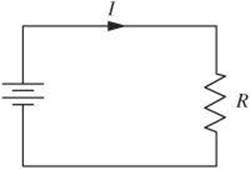
If the emf is tripled while R is held constant, the current will be
(A) 1/9 I
(B) 1/3 I
(C) I
(D) 3I
(E) 9I
47. What particles make up an atom of potassium ![]() ?
?
(A) 42 protons, 19 electrons, 42 neutrons
(B) 23 protons, 23 electrons, 19 neutrons
(C) 23 protons, 19 electrons, 42 neutrons
(D) 19 protons, 23 electrons, 19 neutrons
(E) 19 protons, 19 electrons, 23 neutrons
48. The diagram shows a 6-kilogam block suspended from the ceiling. The force exerted on the block by the cord is approximately
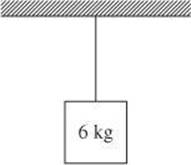
(A) 0 N
(B) 10 N
(C) 26 N
(D) 60 N
(E) 90 N
49. The work done in holding a weight of 20 newtons at a height of 1 meter above the ground for 5 seconds is, in joules,
(A) 0
(B) 4
(C) 25
(D) 50
(E) 100
50. An object starts from rest and accelerates at 6.0 m/s2 for 4.0 seconds. How far does it travel?
(A) 8.0 m
(B) 12 m
(C) 48 m
(D) 96 m
(E) 288 m
51. The Celsius temperature of an object is increased by 40°C. Its Kelvin temperature increases by
(A) 8 K
(B) 10 K
(C) 40 K
(D) 72 K
(E) 233 K
52. A concave spherical mirror has a focal length of 12.0 cm. A candle is placed upright at a distance of 36.0 cm from the mirror. Where is the image of the candle located?
(A) 6.0 cm
(B) 8.0 cm
(C) 9.0 cm
(D) 18.0 cm
(E) 24.0 cm
53. A 2000-newton object falls freely from rest. If it drops 15 meters, its kinetic energy just before it strikes the ground is
(A) 1,300 J
(B) 15,250 J
(C) 25,000 J
(D) 30,000 J
(E) 45,000 J
54. An optical fiber is made up of silica with an index of refraction of about 1.44. How fast does light travel in this optical fiber?
(A) 1.56 × 106 m/s
(B) 4.08 × 106 m/s
(C) 2.08 × 108 m/s
(D) 4.32 × 108 m/s
(E) 4.44 × 108 m/s
55. If the addition of 4,000 joules of heat to 20 kilograms of a substance raises its temperature 2°C, the specific heat of the substance is
![]()
![]()
![]()
![]()
![]()
56. During one cycle, a gasoline engine receives 218.2 J of energy from combustion and loses 146.5 J by heat to exhaust. The efficiency of the engine is about
(A) 26%
(B) 33%
(C) 49%
(D) 67%
(E) 113%
57. If the speed of sound in air is 345 m/s, what is the third harmonic of a 2.15 m-long pipe that is open at both ends?
(A) 80.2 Hz
(B) 83.2 Hz
(C) 110 Hz
(D) 160 Hz
(E) 241 Hz
Questions 58 and 59 refer to an inclined plane with a length of 8.0 m that is lifted 2.0 meters above the ground on one end. A person needs to push a 700-newton object up the plane. The force of friction is 50 newtons.
58. What is the potential energy gained by the object when it is raised to the top of the plane?
(A) 700 J
(B) 900 J
(C) 1000 J
(D) 1400 J
(E) 1500 J
59. Approximately what is the minimum force required to push the object up the plane?
(A) 175 N
(B) 225 N
(C) 500 N
(D) 650 N
(E) 750 N
60. A 90-kg object moves around a flat, circular track. The track has a radius of 20 meters and the object completes one revolution every 8.0 seconds. The speed of the object is
(A) 2.5 m/s
(B) 7.9 m/s
(C) 11.3 m/s
(D) 15.7 m/s
(E) 23.1 m/s
61. A 6-kg object is at rest on a frictionless horizontal plane.
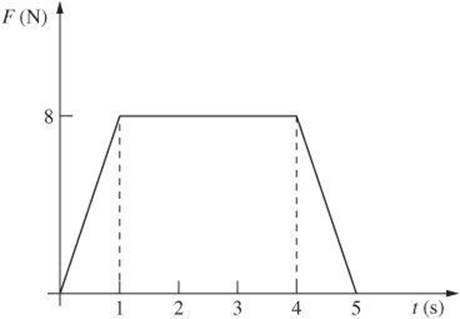
If the object is moved from rest by the force shown, what is the velocity of the object at time ![]() s?
s?
(A) 2 m/s
(B) 6 m/s
(C) 12 m/s
(D) 16 m/s
(E) 32 m/s
62. The half-life of an isotope is 6 years. What fraction of a sample of that isotope will remain after 18 years?
(A) 1/18
(B) 1/12
(C) 1/8
(D) 1/6
(E) 1/3
63. How many meters will a 4.00-kilogram ball travel if it starts from rest and falls freely for 3.00 seconds?
(A) 14.7 m
(B) 15.0 m
(C) 29.4 m
(D) 44.1 m
(E) 88.2 m
64. Which quantity is equivalent to ![]() ?
?
(A) 1 Calorie
(B) 1 calorie
(C) 1 British thermal unit
(D) 1 joule
(E) 1 therm
65. An incoming ray of light in a vacuum with a wavelength of 589 nm strikes diamond at an angle of 26.0° to the normal. If the index of refraction for diamond is 2.42, the angle of refraction will be
(A) 0.41°
(B) 4.30°
(C) 7.21°
(D) 10.4°
(E) 18.1°
66. What voltage is required to establish a current of 0.5 A through a resistance of 0.8 Ω?
(A) 0.3 V
(B) 0.4 V
(C) 0.6 V
(D) 1.3 V
(E) 1.6 V
67. A current-carrying wire is placed in the magnetic field shown. Toward which point does the wire experience a magnetic force?

(A) A
(B) B
(C) C
(D) D
(E) E
68. The units used to measure potential difference are
(A) joules
(B) volts
(C) newtons
(D) coulombs
(E) amperes
69. An object traveling around a curve at a speed of 5 meters per second has a centripetal force of 45 newtons. What will happen to the centripetal force if the speed of the object increases to 10 meters per second?
(A) It will be divided by 4.
(B) It will be halved.
(C) It will be unchanged.
(D) It will be doubled.
(E) It will be quadrupled.
70. A process in which volume remains constant is described as
(A) isothermic.
(B) isochoric.
(C) isometric.
(D) isobaric.
(E) isosceles.
Questions 71 and 72 can be solved by applying the Bohr radius, which is 5.3 × 10–11 m. It is equal to the most probable distance between the proton and electron in a hydrogen atom in its ground state. The charge on an electron is equal and opposite to the charge on a proton, which is 1.60 × 10–19 C. The Coulomb constant has an approximate value of ![]() .
.
71. The electric force between an electron and a proton in a hydrogen atom is
(A) 3.6 × 10–47 N
(B) 2.3 × 10–28 N
(C) 4.3 × 10–18 N
(D) 8.2 × 10–8 N
(E) 3.7 × 10–6 N
72. What is the electrical potential energy of the hydrogen atom?
(A) –4.34 × 10–18J
(B) –8.2 × 10–8 J
(C) –27.1
(D) –2.3 × 10–28J
(E) –4.83 × 10–28J
73. Which range of the electromagnetic spectrum consists of waves with the shortest wavelengths?
(A) radio waves
(B) infrared waves
(C) gamma rays
(D) ultraviolet light
(E) microwaves
74. At ![]() , a ball is at rest at the top of a 20-m inclined plane. Then the ball rolls down the plane with constant acceleration. If the ball rolls 2 meters in the first second, how far will it have rolled at
, a ball is at rest at the top of a 20-m inclined plane. Then the ball rolls down the plane with constant acceleration. If the ball rolls 2 meters in the first second, how far will it have rolled at ![]() seconds?
seconds?
(A) 6 m
(B) 9 m
(C) 12 m
(D) 18 m
(E) 20 m
75. A 20.0-g sample of water is cooled from steam at 128.0°C to a liquid at 62.0°C. If ![]() ,
, ![]() , and
, and ![]() , the amount of energy removed during this process is
, the amount of energy removed during this process is
(A) 1.13 × 103 J
(B) 2.41 × 103 J
(C) 5.02 × 103 J
(D) 4.52 × 104 J
(E) 4.95 × 104 J
STOP
IF YOU FINISH BEFORE TIME IS CALLED, YOU MAY CHECK YOUR WORK ON THIS TEST ONLY. DO NOT
TURN TO ANY OTHER TEST IN THIS BOOK.
ANSWER KEY
1. C
2. E
3. D
4. A
5. B
6. C
7. A
8. D
9. B
10. C
11. B
12. C
13. B
14. E
15. B
16. D
17. A
18. B
19. D
20. D
21. B
22. C
23. C
24. B
25. D
26. A
27. D
28. D
29. A
30. E
31. C
32. C
33. A
34. A
35. A
36. D
37. A
38. C
39. D
40. B
41. D
42. B
43. A
44. E
45. A
46. D
47. E
48. D
49. A
50. C
51. C
52. D
53. D
54. C
55. D
56. B
57. E
58. D
59. B
60. D
61. B
62. C
63. D
64. D
65. D
66. B
67. C
68. B
69. E
70. B
71. D
72. A
73. C
74. D
75. E
QUESTION ANSWERS AND EXPLANATIONS
1. C Plutonium–239 decays by alpha particle emission.
2. E Thorium–234 decays by beta particle emission.
3. D Nuclear fusion occurs when lighter nuclei combine to form a heavier nucleus.
4. A Nuclear fission occurs when a heavy nucleus, such as U–235, breaks into lighter nuclei.
5. B According to Newton’s second law of motion, an object accelerates when an unbalanced force is applied to it. The gravitational force is the unbalanced force acting on the acorn.
6. C According to Newton’s third law of motion, when a force is exerted on an object, the object exerts an equal and opposite force. When the astronaut exerts a force on the pack, the pack exerts an equal and opposite force on the astronaut.
7. A According to Newton’s first law of motion, an unbalanced force is required to change the motion of an object. Because the teams are tied, the forces are balanced and there is no change in motion.
8. D The law of universal gravitation states that there is a force of attraction between every pair of objects in the universe. Jupiter exerts a force of attraction on its moons. The moons, in turn, attract a force of attraction on Jupiter.
9. B An object placed between the center of curvature and the focal point of a converging mirror will form a real, inverted image.
10. C An object placed within the focal length of a diverging mirror will form a virtual, upright image.
11. B An object placed at 2F of a converging lens will form a real, inverted image.
12. C An object placed between the focal point and the surface of a converging mirror will form a virtual, upright image.
13. B The magnitude of the vector 2A is 4. The magnitude of the vector B is 3. The angle between the vectors is 90°. Use the Pythagorean theorem to find the magnitude of 2A-B as 5, as shown.
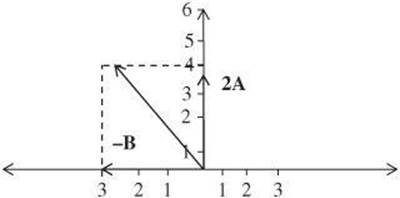
14. E When the atom in the ![]() state makes just a single transition, it can end up in either the
state makes just a single transition, it can end up in either the ![]() state or the
state or the ![]() state. The energy of the photon released is just the difference in the energy of the initial and final atomic states. In this case, the photon energy is either
state. The energy of the photon released is just the difference in the energy of the initial and final atomic states. In this case, the photon energy is either ![]() or
or ![]() .
.
15. B Both the angle of incidence and the angle of reflection are measured relative to the normal. They are equal in magnitude, and on opposite sides of the normal.
16. D The wavelength is one full cycle, or 1.0 m.
17. A The period is the inverse of the frequency. ![]() Then
Then ![]() .
.
18. B Wavelength = speed/frequency, so ![]() .
.
19. D The force is directly proportional to the masses and indirectly proportional to the square of the distance. This results in a ratio of ¾, or 0.75.
20. D The amount of energy required to melt the ice is found by ![]() .
.
21. B The heat required can be found using ![]() .
.
22. C The magnetic field at the center of a coil is directly proportional to the current in the coil. If the current remains constant over time, so does the magnetic field.
23. C Because the forces act in opposite directions, the magnitude of the resultant force is the difference between them. The direction is in the direction of the greater force.
24. B Alpha rays are made up of streams of alpha particles, which are helium nuclei.
25. D Draw vectors to form a right triangle. Then use trigonometric relationships to find the northward-pointing vector. The answer makes sense because the plane is traveling more toward the north than toward the east.
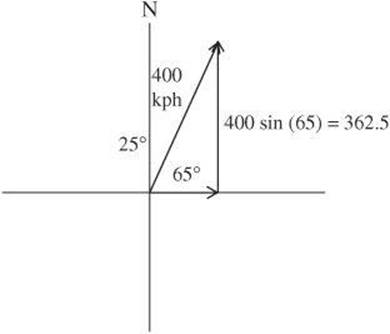
26. A Draw vectors to form a right triangle. Then use trigonometric relationships to find the eastward-pointing vector.
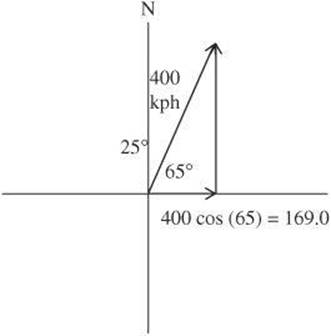
27. D Find the volume change using the formula ![]() . Then use the formula
. Then use the formula ![]() to find the work.
to find the work. ![]() .
.
28. D The equivalent resistance is calculated using a reciprocal relationship rather than a direct sum. Therefore, III is incorrect.
29. A The mass numbers must balance on both sides of the equation: ![]() . The atomic numbers must also balance:
. The atomic numbers must also balance: ![]() .
.
30. E Acceleration is directly proportional to the net force and inversely proportional to the mass: ![]() . so
. so ![]() and
and ![]() .
.
31. C The mass numbers must balance on both sides of the equation: ![]() . The atomic numbers must also balance:
. The atomic numbers must also balance: ![]() .
.
32. C Draw a diagram to represent the hiker’s path. Let I represent the first part of the hike and II represent the second part. Find I + II.
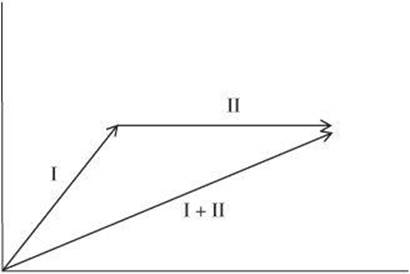
![]()
![]()
![]()
![]()
![]()
![]()
33. A The net excess charge on these two spheres is +2 microcoulombs (+8 + (-6)). Because charge is conserved, each sphere will carry +1 micro-coulomb when the excess charge is shared equally.
34. A The strength of an electromagnet is increased by increasing the number of coils of wire, adding an iron core to a solenoid, and increasing the current through the wire.
35. A One method of approaching this question is to rewrite each choice in standard form. The choices then become (A) 3.5 × 10–1 m, (B) 3.5 × 10–2 m, (C) 3.5 × 10–6 m, (D) 3.5 × 10–3 m, (E) 3.5 × 10–3 m. The largest quantity is then the one with the greatest exponent, which is choice A.
36. D According to the first law of thermodynamics, adding 10 joules of heat to an ideal gas would increase the internal energy of the gas by 10 joules. However, the internal energy of the gas decreases by the 6 joules converted to work done by the gas. The net change in the internal energy of the gas is 10 joules -6 joules, which is a net increase of 4 joules.
37. A The total resistance is found by Ohm’s Law, ![]() . So
. So ![]()
![]() . The total resistance is the sum of the three individual resistances.
. The total resistance is the sum of the three individual resistances. ![]() , and
, and ![]() .
.
38. C The power dissipated equals the product of the square of the current and the resistance, ![]() . Substitute the given values to find that
. Substitute the given values to find that ![]() .
.
39. ![]() ,
,  ,
,  ,
, ![]()
40. B According to the first law of thermodynamics, ![]() . Only I and IV will lead to a positive ΔU.
. Only I and IV will lead to a positive ΔU.
41. D The magnetic field established by a current-carrying wire takes the shape of circles surrounding the wire.
42. B The magnitude of the electric field at any location due to a point charge is inversely proportional to the square of the distance r from the location to the charge. As the distance increases, the magnitude of the electric field decreases, so the farthest point has the least magnitude.
43. A The electron is negatively charged, so it will experience a force directed straight toward the charge +Q, which is fixed in position. The only labeled point where a force toward +Q is directed toward the bottom of the page is point A.
44. E An alpha particle ![]() He is made up of 2 neutrons and 2 protons. When they are emitted, the atomic number decreases by 2 and the mass number decreases by 4.
He is made up of 2 neutrons and 2 protons. When they are emitted, the atomic number decreases by 2 and the mass number decreases by 4.
45. A The resultant force is greatest when the magnitudes of the two forces combine. This occurs when they act in the same direction and, therefore, have an angle of 0° between them.
46. D In this series circuit, the emf across the battery is equal to the voltage V across the resistor. If the emf is tripled, V is also tripled. The current I in the resistor is given by Ohm’s Law, ![]() , so if V is tripled while the resistance R remains constant, then I is also tripled.
, so if V is tripled while the resistance R remains constant, then I is also tripled.
47. E The nuclear symbol for an element shows the atomic number, or number of protons, as a subscript to the left of the symbol. The superscript is the mass number, or total number of nucleons. If the atom is electrically neutral, the number of protons equals the number of electrons.
48. D The block is in equilibrium, so the force acting on it must be balanced. The force exerted by the cord on the block must be equal in magnitude and opposite in direction to the weight of the block. The weight of the block is equal to m times g. If g is approximated as 10 m/s2, the force is 60 newtons.
49. A Work is determined by the product of the force exerted on an object and the distance the object moves as a result of that force. Although a force is exerted, the object does not move as a result of that force, so no work is done.
50. ![]()
51. C Each unit on the Celsius scale is the same as a unit on the Kelvin scale. Therefore, an increase of 40°C on the Celsius scale is equal to an increase of 40 kelvins on the Kelvin scale.
52. D Use the mirror equation to relate the object distance, image distance, and focal length: ![]() . Rearrange to solve for q, the image distance
. Rearrange to solve for q, the image distance ![]() . So,
. So, ![]() .
.
53. D The kinetic energy just before it strikes the ground is equal to the potential energy it had just before falling.
![]()
54. C The angle of refraction equals the ratio of the speed of light in a vacuum to the speed of light in the silica.
![]()
55. D The change in temperature ΔT of a mass m of a substance is related to the amount of heat added to it by the equation ![]() , where c is the specific heat of the substance. Solving for the specific heat and substituting the given quantities,
, where c is the specific heat of the substance. Solving for the specific heat and substituting the given quantities,
![]()
56. B The efficiency of a heat engine is determined by finding the ratio of the work done by the engine to the energy transferred by heat, ![]() . Substituting in the given values gives
. Substituting in the given values gives ![]() , which is about 33%.
, which is about 33%.
57. E For a pipe that is open at both ends, all harmonics are present. Use the equation for the harmonic series to find the fundamental frequency: ![]() . The third harmonic is three times the fundamental frequency:
. The third harmonic is three times the fundamental frequency: ![]() .
.
58. D The increase in potential energy is equal to the product of the weight and the height. ![]() .
.
59. B The ratio of the height of the plane to the length of the plane is ![]() . The parallel component is the product of this ratio and the weight of the object. So, parallel component =
. The parallel component is the product of this ratio and the weight of the object. So, parallel component = ![]() . The person needs to overcome the parallel component, as well as the force of friction. So,
. The person needs to overcome the parallel component, as well as the force of friction. So, ![]() .
.
60. D The speed depends on the circumference and the period. ![]() .
.
61. B Find the impulse by determining the area under the graph, and then use it to find the velocity.
![]() ,
, ![]()
62. C The half-life is 6 years, so 18 years is 3 half-lives. After 1 half-life, ½ of the sample remains. After 2 half-lives, ¼ of the sample remains. After 3 half-lives, 1/8 of the sample remains.
63. D The distance ![]()
64. D The joule is the SI unit of energy equivalent to the quantity described.
65. D By rearranging Snell’s Law, you find that ![]() Substitute in the known values and solve:
Substitute in the known values and solve: ![]() .
.
66. B According to Ohm’s Law, ![]() . Therefore,
. Therefore, ![]() .
.
67. C The right-hand rule can be used to determine the direction of the force. Place your thumb in the direction of the current. Your straightened fingers point in the direction of the magnetic force.
68. B Potential difference is measured in volts and is, therefore, often known as voltage.
69. E The centripetal force is directly related to the square of the velocity. If the velocity is doubled, the force will be multiplied by 4.
70. B The term isochoric describes a process at constant volume.
71. D Use Coloumb’s Law to find the magnitude of the electric force. The magnitude of the charge on each particle is the same. The signs of the charges determine the direction of the force and need not be included in the calculation to find the magnitude of the force.

72. A The electrical potential energy for a pair of charges is found by ![]() . Substitute the known values into the equation to solve:
. Substitute the known values into the equation to solve:
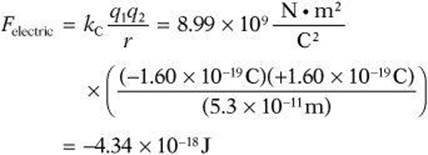
73. C Gamma rays have the shortest wavelengths and the greatest frequencies of the waves listed.
74. D Because the initial speed of the ball is zero, distance x down the plane as a function of time t is related to acceleration a by the equation ![]() . If the ball rolls 2 meters in 1 second, you can find that the acceleration is 4 m/s2. Using the equation again with this acceleration and
. If the ball rolls 2 meters in 1 second, you can find that the acceleration is 4 m/s2. Using the equation again with this acceleration and ![]() seconds gives a distance of 18 meters.
seconds gives a distance of 18 meters.
75. E Find the energy change of the cooling steam:
![]()
Find the energy change of the condensing steam :
![]()
Find the energy change of the cooling water:
![]()
![]()
PRACTICE TEST 2
Treat this practice test as the actual test, and complete it in one 60-minute sitting. Use the following answer sheet to fill in your multiple-choice answers. Once you have completed the practice test:
1. Check your answers using the Answer Key.
2. Review the Answers and Explanations.
3. Complete the Score Sheet to see how well you did.
ANSWER SHEET
Tear out this answer sheet and use it to complete the practice test. Determine the BEST answer for each question. Then fill in the appropriate oval.
